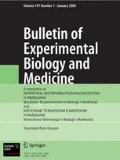We studied the level of heat shock protein HSP70 under conditions of oxidative stress in 47 patients with apnea. The control group included 13 healthy subjects without verified apnea. Blood serum, plasma, and erythrocyte hemolysate were used to determine LPO and anti-oxidant protection components by spectrophotometrical and spectrofluorometrical methods. HSP70 was assayed by ELISA. A direct relationship was established between the intensity of oxidative stress and HSP70 expression in patients with apnea. Quantitative determination of HSP70 can be used as a molecular marker in the early diagnosis and prognosis of the development of various pathological conditions in hypoxia.
Similar content being viewed by others
References
Dysregulation Pathology. Kryzhanovskii GN, ed. Moscow, 2002.
Kuznik BI, Linkova NS, Khavinson VKh. Heat shock proteins: Changes related to aging, development of thrombotic complications, and peptide regulation of the genome. Adv. Gerontology. 2012;2(3):175-186.
Madayeva IM, Kolesnikova LI, Petrova VA, Shevyrtalova ON, Sholokhov LF. Changes in the processes of the lipid peroxidation and antioxidant defense system in patients with obstructive sleep apnoea syndrome. Patol. Fiziol. Eksp. Ter. 2009;(3):24-27. Russian.
Madaeva IM, Petrova VA, Kolesnikova LI, Shevyrtalova ON. Obstructive sleep apnea/hypopnea and lipid peroxidation. Pul’monologia. 2009;(2):65-69. Russian.
Nosareva OL, Ryazantseva NV, Stepovaya EA, Shakhristova EV, Stepanova EA, Gulaya VS. The role of heat shock proteins 27 and 70 in redox-dependent regulation of apoptosis in Jurkat tumor cells. Biomed. Khimiya. 2016;62(6):670-673. Russian.
Pastukhov YF, Ekimova IV, Khudik KA, Guzhova IV. Protein 70 kDa in the control of sleep and thermoregulation. J. Evol. Biochem. Physiol. 2008;44(1):74-81.
Kolesnikova LI, Grebenkina LA, Olifirenko VP, Osipova EV, Dolgikh MI, Kurashova NA, Darenskaya MA. State registration of computer programs. RU 2011617323. The program for calculating the coefficient of oxidative stress based on the parameters of lipid peroxidation-antioxidant protection in the blood. Registration data July 28, 2011.
Dulin E, García-Barreno P, Guisasola MC. Extracellular heat shock protein 70 (HSPA1A) and classical vascular risk factors in a general population. Cell Stress Chaperones. 2010;15(6):929-937.
Gessi S, Merighi S, Bencivenni S, Battistello E, Vincenzi F, Setti S, Cadossi M, Borea PA, Cadossi R, Varani K. Pulsed electromagnetic field and relief of hypoxia-induced neuronal cell death: the signaling pathway. J. Cell. Physiol. 2019. Jan 17. https://doi.org/10.1002/jcp.28149
Hayashi M, Fujimoto K, Urushibata K, Takamizawa A, Kinoshita O, Kubo K. Hypoxia-sensitive molecules may modulate the development of atherosclerosis in sleep apnoea syndrome. Respirology. 2006;11(1):24-31.
Kolesnikova LI, Madaeva IM, Semenova NV, Vlasov BY, Grebenkina LA, Darenskaya MA, Dolgikh MI. Antioxidant potential of the blood in men with obstructive sleep breathing disorders. Bull. Exp. Biol. Med. 2013;154(6):731-733.
Lavie L, Dyugovskaya L, Golan-Shany O, Lavie P. Heat-shock protein 70: expression in monocytes of patients with sleep apnoea and association with oxidative stress and tumor necrosis factor-alpha. Eur. Sleep Res. Soc. 2009;19(1, Pt 2):139-147.
Qu B, Jia Y, Liu Y, Wang H, Ren G, Wang H. The detection and role of heat shock protein 70 in various nondisease conditions and disease conditions: a literature review. Cell Stress Chaperones. 2015;20(6):885-892.
Rane A, Rajagopalan S, Ahuja M, Thomas B, Chinta SJ, Andersen JK. Hsp90 Co-chaperone p23 contributes to dopaminergic mitochondrial stress via stabilization of PHD2: implications for Parkinson’s disease. Neurotoxicology. 2018;65:166-173.
Wang Y, Jia C, Li QS, Xie CY, Zhang N, Qu Y. BAG-1L Protects SH-SY5Y neuroblastoma cells against hypoxia/re-oxygenation through up-regulating HSP70 and activating PI3K/AKT signaling pathway. Neurochem. Res. 2017;42(10):2861-2868.
Author information
Authors and Affiliations
Corresponding author
Additional information
Translated from Byulleten’ Eksperimental’noi Biologii i Meditsiny, Vol. 169, No. 5, pp. 627-630, May, 2020
Rights and permissions
About this article
Cite this article
Madaeva, I.M., Kurashova, N.A., Semenova, N.V. et al. Heat Shock Protein HSP70 in Oxidative Stress in Apnea Patients. Bull Exp Biol Med 169, 695–697 (2020). https://doi.org/10.1007/s10517-020-04957-9
Received:
Published:
Issue Date:
DOI: https://doi.org/10.1007/s10517-020-04957-9




